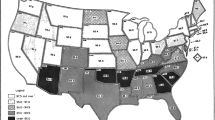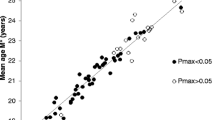Abstract
There is increased demand for maternal mortality estimates as a result of the choice of the Maternal Mortality Ratio as the key indicator for Millennium Development Goal 5. Given this strong demand, the United Nations Principles and Recommendations for Population Censuses suggest the inclusion of questions on recent household deaths, plus questions to identify pregnancy-related deaths in countries lacking empirical, national estimates. This paper evaluates the results of census-based measurement of pregnancy-related mortality using three different types of consistency checks applied in selected countries. Results from these evaluations are mixed. Overall, the census approach seems to produce robust estimates of the number of births. However, the consistency and plausibility of results relating to mortality vary substantially by country and by indicator. It is not clear whether the census-based methodology performs better or worse than the frequently used sibling histories. The results presented here clearly demonstrate the need for careful data evaluation and interpretation.


Similar content being viewed by others
Notes
Whether this attention is warranted, given the burden of disease generated by maternal mortality, is beyond the scope of this paper.
Calculated for the intercensal period, in the case of Burkina Faso applying the age-specific rates for 2006 to the intercensal population age distribution and in the case of Zimbabwe averaging the 1992 and 2002 age-specific rates and applying them to the intercensal population age distribution.
References
Bennett, N. G., & Horiuchi, S. (1981). Estimating the completeness of death registration in a closed population. Population Index, 47(2), 202–221.
Brass, W. (1975). Methods for estimating fertility and mortality from limited and defective data. Chapel Hill: International Program of Laboratories for Population Statistics.
Central Statistical Office [Zimbabwe] and MACRO International Inc. (2000). Zimbabwe Demographic and Health Survey 1999. Calverton MD: Central Statistical Office and MACRO International Inc.
Central Statistical Office Harare, Zimbabwe and Macro International Inc. Calverton, Maryland USA. (2007). Zimbabwe Demographic and Health Survey 2005–06. Calverton MD: Central Statistical Office and MACRO International Inc.
Coale, A. J., Demeny, P., & Vaughan, B. (1983). Regional model life tables and stable populations (2nd ed.). New York: Academic Press.
Dorrington, R. E., Timæus, I. M., & Gregson, S. (2006). Adult mortality in Southern Africa using deaths reported by households: Some methodological issues and results. Paper presented at the Annual conference of the Population Association of America. Los Angeles, 30 March-1 April.
Garenne, M., McCaa, R., & Nacro, K. (2008). Maternal mortality in South Africa, 2001: From demographic census to epidemiological investigation. Population Health Metrics, 6(4), 1–13.
Hill, K. (1987). Estimating census and death registration completeness. Asian and Pacific Population Forum, 1(3), 8–13, 23–24.
Hill, K., Queiroz, B., Wong, L., Plata, J., Del Popolo, F., Rosales, J., et al. (2009a). Estimating pregnancy-related mortality from census data: Experience in Latin America. Bulletin of the World Health Organization, 87(4), 288–295.
Hill, K., You, D., & Choi, Y. (2009b). Death distribution methods for estimating adult mortality: Sensitivity analysis with simulated data errors. Demographic Research, 21, 235–254.
Institut National de la Statistique et de la Démographie, Ministère de l’économie et du Développement, Ouagadougou, Burkina Faso, and ORC Macro, Calverton, Maryland, USA. (2004). Enquête démographique et de santé 2003. Calverton, MD: ORC Macro.
Melendez, J. H., Ochoa Vasquez, J. C., & Villanueva, Y. (1999). Investigación sobre mortalidad materna y de mujeres en edad reproductiva en Honduras. Tegucigalpa: Secretaría de Salud Pública.
National Institute of Population Research and Training (NIPORT), ORC Macro, Johns Hopkins University and ICDDR, B. (2003). Bangladesh maternal health services and maternal mortality survey 2001. Dhaka, Bangladesh and Calverton, Maryland (USA): NIPORT, ORC Maro, Johns Hopkins University, and ICDDR,B.
Shahidullah, M. (1995). The sisterhood method of estimating maternal mortality: The Matlab experience. Studies in Family Planning, 26(2), 101–106.
Stanton, C., Abderrahim, N., & Hill, K. (2000). An assessment of DHS maternal mortality indicators. Studies in Family Planning, 31(2), 110–125.
Stanton, C., Hobcraft, J., Hill, K., et al. (2001). Every death counts: Measurement of maternal mortality via a census. Bulletin of the World Health Organization, 79(7), 657–664.
Stecklov, G. (1995). Maternal mortality estimation: Separating pregnancy-related and non-pregnancy-related risks. Studies in Family Planning, 26(1), 33–38.
United Nations. (1983). Manual X: Indirect techniques for demographic estimation. ST/ESA/SER.A/81. Population Studies, No. 81. Department of International Economic and Social Affairs. New York.
United Nations. (2007). Principles and recommendations for population and housing censuses. Statistics Division, Department of Economic and Social Affairs. ST/ESA/STAT/SER.M/67?Rev.2. New York.
United Nations. (2009). World population prospects: The 2008 revision. Accessed online 26 July 2009 at http://esa.un.org/unpp/.
World Health Organization (WHO). (1993). International statistical classification of diseases and related health problems 10th Revision. Geneva.
World Health Organization (WHO). (2007). Maternal mortality in 2005: Estimates developed by WHO, UNICEF, UNFPA and the World Bank. Geneva.
Zlotnik, H., & Hill, K. (1981). The use of hypothetical cohorts in estimating demographic parameters under conditions of changing fertility and mortality. Demography, 18(1), 103–122.
Author information
Authors and Affiliations
Corresponding author
Rights and permissions
About this article
Cite this article
Hill, K., Stanton, C. Measuring maternal mortality through the census: rapier or bludgeon?. J Pop Research 28, 31–47 (2011). https://doi.org/10.1007/s12546-011-9058-1
Published:
Issue Date:
DOI: https://doi.org/10.1007/s12546-011-9058-1




